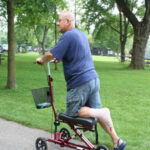My father recently had a total knee replacement and it rendered him incapacitated for days following surgery. Total knee replacement doesn’t mean that two days after surgery, you’re bouncing around on your new titanium knee. It takes weeks of therapy to get the body used to total knee replacement. But a person with new total knee replacement must not neglect upper body exercise routines.
Total knee replacement surgery means that the patient not only is confined to a walker for days, but can only be up and about for very limited periods of time. Following surgery, the patient is essentially living in a seated position, but from here, he or she can conduct exercise routines for upper body muscles. The patient’s upper body muscles will benefit tremendously from weight lifting workouts.
Just because a person is confined pretty much to a chair doesn’t mean he or she shouldn’t perform exercise routines for the shoulder, back and arm muscles.
Upper body exercises for person with total knee replacement
Dumbbells are a must. Several pairs of dumbbells should already be waiting for the patient’s arrival home. The patient must sit in a stable seat that has no arm rests. Such seats can be found at many different stores. The fact he or she had total knee replacement in NO way alters how the dumbbell workouts should be conducted. But it’s a fact that some people, especially those who’ve never done any weight lifting, don’t even think to do any upper body exercises while their lower body is out of commission.
The rule of thumb is to work whatever you CAN, and in the case of total knee replacement, it’s the upper body. While seated with good posture, the person can do any classic dumbbell exercise routine. Here are some:
Biceps Curls: Hold dumbbells at your sides, palms facing away from you, arms hanging straight at your sides, and bend only lower arms to bring dumbbells upward. Keep upper arms hanging straight at your sides.
Reverse Biceps Curls: Same as above except palms face you in the starting position of arms hanging straight at your sides.
Shoulder Flexion: Hold dumbbells with any palm angle, and, keeping arms straight and shoulders relaxed, lift them up in front of you so that your arms are parallel with floor. Go no higher, then lower.
Shoulder Abduction (Lateral Raises): Hang arms straight at sides, then simply raise them on either side of you so that arms are parallel with floor. Go no higher, then lower.
Shoulder Presses: Hold dumbbells at shoulder level, elbows pointing to floor, palms facing away from you. Now, simply push them above your head, straightening your arms. A variation is to do this with palms facing each other. Another variation is to combine shoulder presses with dumbbell curls.
Triceps Presses: Hold dumbbells above head, arms straight, as you would at the completion of a shoulder press. Keeping upper arms fixed in place, bend only lower arms so that dumbbells end up behind your head, elbows pointing to ceiling. Then straighten arms. You can also do this one arm at a time.
Bent-over Rows: Lean forward, arms hanging at sides, slight arch in lower back. Now, pull dumbbells upward towards your rib cage. Keep upper arms against your sides. This motion is identical to pulling on a lawn mower cord to start the machine.
Shoulder Shrugs: Hang arms straight, holding dumbbells with any palm angle. Keeping arms straight, shrug your shoulders. Hold for a few seconds, then release.
How many sets?
I recommend four sets per exercise with 1-2 minutes’ rest in between. You have all the time in the world, remember. Also realize that total knee replacement means severe restriction in calorie-burning. It’s unlikely that you can overdo upper body exercises.
How many reps?
8 to 20. If you can do more than 20, use heavier dumbbells.
How often?
Never do same exercise two days in a row. Three times a week will work if you apply moderate effort; and twice a week will work if you apply intense effort.







